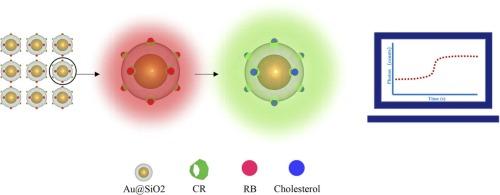高灵敏度的胆固醇检测使用电泳沉积的硅涂层金纳米颗粒,以增强FRET的效果
IF 3.7
1区 化学
Q1 CHEMISTRY, ANALYTICAL
引用次数: 0
摘要
我们报告了一种灵敏的检测方法,该方法采用二氧化硅涂层金纳米颗粒(Au@SiO₂)来增强荧光分子罗丹明绿(RG)和罗丹明B (RB)之间的Förster共振能量转移(FRET),该方法已被用于检测胆固醇作为概念验证研究。激发光谱和时间分辨荧光衰减分析表明Au@SiO2的存在增强了RB的激发,缩短了供体的荧光寿命,促进了能量传递过程,提高了FRET效率和速率。在此过程中,采用一锅法合成了尺寸均匀的Au@SiO₂纳米颗粒,其局部表面等离子体共振(LSPR)峰与RB的激发峰相匹配。利用优化的电泳沉积方法将这些纳米颗粒固定在ITO载玻片上,然后用氨基丙基硅烷进行表面胺化,从而制备了增强底物。rg修饰的羧甲基-β-环糊精(CR)作为胆固醇识别单元,随后通过酰胺键反应与氨基功能化Au@SiO₂纳米颗粒连接。采用RB作为FRET受体,通过记录CR的荧光来检测胆固醇,检测限达到8.0 pmol/L,并且系统具有可重复使用的性能。本文章由计算机程序翻译,如有差异,请以英文原文为准。

Highly sensitive cholesterol detection using electrophoretic deposition of silica-coated gold nanoparticles to enhance the FRET effect
We report a sensitive detection method that employs silica‑coated gold nanoparticles (Au@SiO₂) to enhance Förster resonance energy transfer (FRET) between fluorescence molecules rhodamine green (RG) and rhodamine B (RB), which has been applied to the detection of cholesterol as a proof-of-concept study. Excitation spectroscopy and time-resolved fluorescence decay analyses revealed that the presence of Au@SiO2 enhanced the excitation of RB, shortened the donor’s fluorescence lifetime, facilitated the energy transfer process, and increased both the FRET efficiency and rate. In this process, uniformly sized Au@SiO₂ nanoparticles are synthesized using a one-pot method, with their localized surface plasmon resonance (LSPR) peak matching the excitation peak of RB. An enhancement substrate is fabricated by immobilization of these nanoparticles on an ITO slide using an optimized electrophoretic deposition method, followed by surface amination with aminopropyl silane. RG-modified carboxymethyl-β-cyclodextrin (CR) is employed as the cholesterol recognition unit, which is subsequently linked with the amino-functionalized Au@SiO₂ nanoparticles through an amide bonding reaction. RB was employed as the FRET acceptor, and cholesterol is detected by recording the fluorescence of CR, achieving a detection limit of 8.0 pmol/L, and the system also demonstrates reusable performance.
求助全文
通过发布文献求助,成功后即可免费获取论文全文。
去求助
来源期刊

Sensors and Actuators B: Chemical
工程技术-电化学
CiteScore
14.60
自引率
11.90%
发文量
1776
审稿时长
3.2 months
期刊介绍:
Sensors & Actuators, B: Chemical is an international journal focused on the research and development of chemical transducers. It covers chemical sensors and biosensors, chemical actuators, and analytical microsystems. The journal is interdisciplinary, aiming to publish original works showcasing substantial advancements beyond the current state of the art in these fields, with practical applicability to solving meaningful analytical problems. Review articles are accepted by invitation from an Editor of the journal.
 求助内容:
求助内容: 应助结果提醒方式:
应助结果提醒方式:


